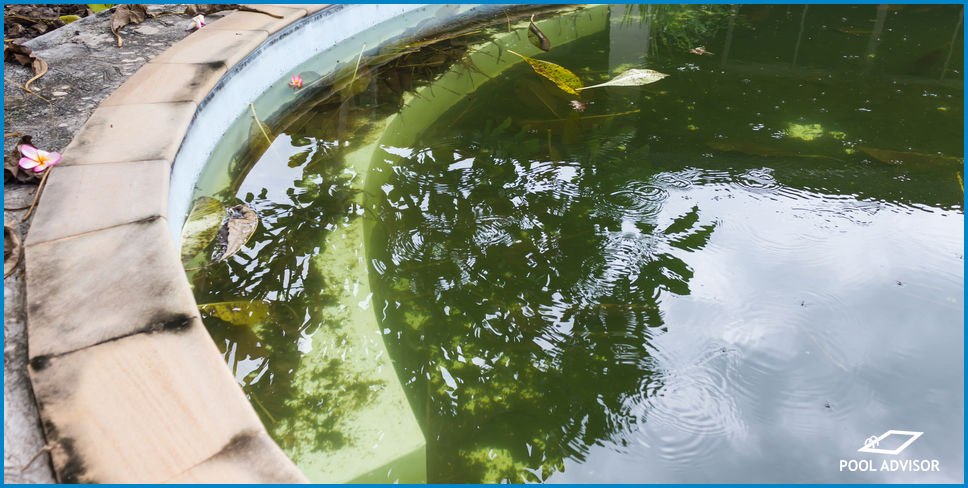
Pool Flocculant Not Working - What Do I Do?
Pool flocculants are recommended to make murky or cloudy pools look clean again, but this isn’t a one-size-fits-all type of solution.
Intended to be used as a last resort, there are actually several pool problems that can affect your water quality which flocculants are unable to remedy.
In this article we will discuss the most common reasons why flocculants fail to work as well as what steps you should take if your flocculant doesn’t work.
Reasons Why Flocculant Fails to Work
Flocculants Do Not Fix Algae Problems
Pools that have green water or green buildup along the surfaces of the pool are suffering from an algae infestation. Algae is not considered debris, and because it is alive, it responds very differently when chemicals like flocculant are introduced.
Algae that is still alive is able to resist being captured by flocculant, making your flocculant ineffective at solving your issue. If your pool is green, you must first take steps to kill off all algae in your pool before seeing if a flocculant is actually necessary.
Sometimes, cloudy or murky pool water can also be caused by bacterial blooms. These are similar to algae infestations in that they are also resistant to flocculants and must be treated using sanitising agents.
Flocculants can clear up dead algae and bacterial cells only, not living ones.
Solution: Kill the microorganisms with shock, then come back and treat with flocculant.
You Haven’t Waited Long Enough
Depending on the product, pool flocculant can take quite a while to work. Quicker products may allow most debris to settle within the first six hours, but many products can take up to 24-48 hours to finish settling all of the debris in your pool.
To determine the correct amount of time that you should leave your pool’s pump off while waiting for your flocculant to clear up any debris, consult the usage instructions provided by your product’s manufacturer.
Because this waiting period can vary widely depending on the brand and concentration of product used, it is necessary to obtain these specifications. If you cannot locate this information, contact the retailer that you purchased your flocculant from.
Solution: Wait for the appropriate amount of time before deciding whether the flocculant is working or not.
Water Cloudiness Caused By Chemical Imbalances
Many causes of water cloudiness appear to be caused by tiny particles of debris when they are actually caused by a variety of chemical imbalances in your pool.
The most common causes of cloudy pool water are high or low chlorine levels and imbalances in your pool’s pH and total alkalinity.
High calcium hardness can also cause cloudy water. This issue is indicative of having too much dissolved calcium and alkalinity in your water, which can lead to the buildup of scale and may also damage your equipment over time.
High water hardness cannot be remedied by using a flocculant, and requires other approaches.
In order to fully address issues with your water chemistry, you will need to purchase a test kit. Only once your chemical levels are within the adequate ranges can you begin to tackle any other problems that may be causing your pool to have murky water.
Solution: Balance your water chemistry before adding flocculant.
What To Do If Flocculant Doesn’t Work
Regardless of the reason, when a flocculant fails to work, it is likely to stick to itself. After this, clumps of flocculant may be suspended in your pool’s water, or it may all settle along the floor of your pool.
Before resuming normal filter operation, you will need to remove as much excess flocculant as possible in order to prevent filter damage.
Step 1 - Use Dip Net
To remove inactive flocculant from your pool, we recommend starting by using a dip net. Remove as many large clumps of debris or flocculant that are floating in or on top of the water as you are able.
Step 2 - Vacuum Pool Base
Afterwards, you will want to vacuum your pool to collect any of the flocculant that has settled to the bottom. Make sure you vacuum your pool to waste, and do not let any flocculant pass through the filter.
Step 3 - Resume Normal Filter Operation
After all large particles of flocculant are removed, you may turn your pump back on and resume filter operation. Because it is possible that some flocculant will be left in your pool at this time, we recommend regularly checking your filter to ensure that it is functioning properly.
It is also a good idea to manually clean or backwash your filter after it has been circulating your flocked water for several hours in order to remove any potential clogs from your equipment.
Summary
Pool flocculant is not the cure for all pool ailments. It is only capable of dealing with specific pool issues and can do more harm than good if added unnecessarily.
If floc is not working in your pool, follow the steps outlined in this article to get your pool back on track and ready for swimming!

Louis
A chemical engineer by trade, Louis is committed to debunking myths in the pool industry by explaining the underlying chemistry and making it accessible to all.
